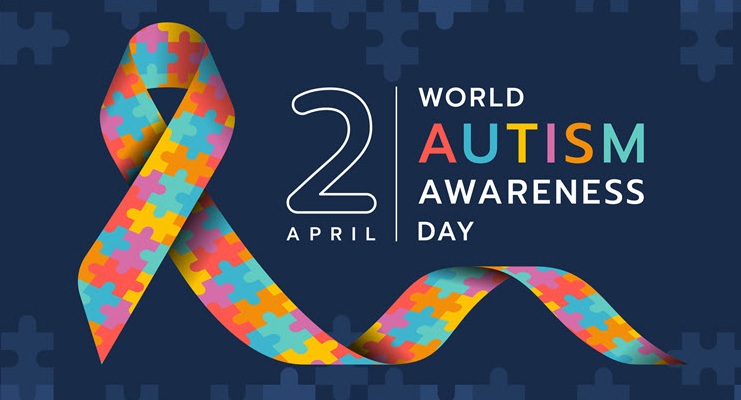WORLD AUTISM DAY
Autism Spectrum Disorder (ASD) is a neurodevelopmental condition characterized by challenges in social interaction, communication, and repetitive behaviours. Even while science has come a long way in understanding autism, there is still a great deal to learn, particularly from the experiences of those who live with the condition. Through the eyes of an autistic child, we explore the world of autism, providing insights into their distinct experiences, difficulties, and abilities. From their perspective the world can be both fascinating and perplexing.
How do they experience and handle sensory overload?
“I am autistic and I feel, sense, or perceive sensations just like you do, but it’s different for me. I experience these sensations without any filtering or dilution”
Every second, the brain processes approximately millions of sensory impressions. A few of those impressions are ones we are aware of. Since our brains aren’t designed to process every impulse we receive in a day, only the most crucial information is sent on for more processing. As a result, we choose and refine our experiences.Children with autism either lack the ability to filter their experiences or have only partially developed this ability. It has to do with how achild with autism perceives their environment and how they filter their experiences. A wide range of experiences are included in the autism spectrum, from sensory sensitivity to social communication challenges.
How might they respond to noises?
“I can’t handle ‘noise’ the way you do. My way of coping is different from yours, and that might seem unusual to you”
Children on the autistic spectrum respond differently to excessive brain stimulation. They struggle greatly to cope with noises and sounds. In order to keep their brains from overloading, they must defend themselves against noise. They make an effort to avoid or leave situations that are overly delicate. However, they find it extremely challenging to block out surrounding sounds when conversing with someone else. When something goes wrong, their minds become chaotic and go into overdrive.If attempts to leave the situation are unsuccessful, children with autism frequently turn to “stimming,” which involves self-stimulating behaviours such as seesawing, jumping, making sounds, counting, and clicking fingers. These behaviours serve to relax their minds and help them manage overstimulation.
How they respond tothe company of others?
“This isn’t part of my usual routine, and I’d prefer to be in my usual place”
Being in crowded settings can pose significant challenges for children with autism. These environments disrupt their routines, introducing unpredictability and chaos, which can be unsettling and distressing. Additionally, crowded places can exacerbate difficulties in speech and language processing. Children with autism may feel overwhelmed, agitated, or unable to cope in such situations, potentially leading to emotional distress or meltdowns.
What is their reaction to eye contact with others?
“My brain throws everything at me, you know? I see every little twitch and squint in their faces. It’s too much, and I can’t concentrate on anything”
Their responses when they make eye contact can vary. Direct eye contact may be uncomfortable or overwhelming for children with autism, causing them to turn away or focus on something else. While making eye contact may not be difficult for some, it may not come effortlessly to others.
Avoiding eye contact is a reaction to extreme discomfort for kids with autism, not a sign of disinterest. Many find it “unnatural” and feel uncomfortable looking someone in the eye.
How do they react to emotions?
“I’m unsure how to respond when people around me are happy or sad. I have emotions, but I prefer to express them in my own way”
Children with autism frequently experience an oversupply of emotions rather than too little, but emotions also serve as stimulants for them. Some can find it difficult to pinpoint their feelings since they are so jumbled. They are pressed for time, unable to sort through and arrange their emotions. Furthermore, a lot of autistic kids put up a lot of effort and strength attempting to emulate non-autistic behavior, which exhausts them.
Why do they often become absorbed in their own world and focus solely on one task?
“I prefer focusing on one task at a time because multitasking is exhausting and challenging for me”
Childrenwith autism can focus hard on one subject and ignore everything else because they are trained to limit external stimulation. Hyper-focus, or total immersion in one task, can have negative consequences, such as ignoring hunger or thirst sensations independent of temperature or other environmental factors.
Children with autism might have special talents and qualities that should be acknowledged despite the many obstacles they encounter. Many are exceptionally detailed-oriented and talented in math, music, or the arts. Their acute perception and creative problem-solving abilities can provide novel insights and inventive solutions. Nevertheless, the emphasis on deficiencies frequently overshadows their assets, creating false impressions about their potential.By exploring autism through the eyes of an autistic child, we gain a deeper understanding of their experiences and emotions. Empathy is crucial in fostering acceptance and inclusion, ensuring that autistic individuals are valued for who they are rather than stigmatized for their differences. It is only through empathy and understanding that we can create a world that is truly inclusive and supportive of all individuals, regardless of neurodiversity.
By acknowledging and celebrating the diversity of the autism spectrum, we can create a more inclusive society that embraces neurodiversity and empowers all individuals to thrive. Through empathy and understanding, we can pave the way for a brighter future where every voice is heard and valued.
(Author is Consultant Psychiatrist, IMHANS Srinagar. Feedback:[email protected])








